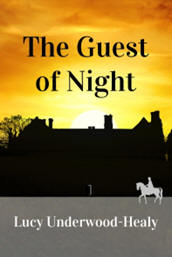Catholic Medical Quarterly Volume 73(2) May 2023
Book Review - The Guest of Night
by Lucy Underwood-Healy: En Route Books and Media, 2021, 418 pages.
Reviewed by Pravin Thevasathan
 Slow
as I was getting into this book, I wondered if it was due to tiredness
that I did not seem to know, easily, who was who. But then, as the book
progressed and really took me into its world of Elizabethan England, so I
began to think that maybe these initial pages were deliberately written to
be a kind of literary introduction to the times which it depicts. In other
words, the slow pace and the various brief introductions may be a way of
easing the reader into what becomes a world fraught with uncertainty as to
who is hiding from whom and why.
Slow
as I was getting into this book, I wondered if it was due to tiredness
that I did not seem to know, easily, who was who. But then, as the book
progressed and really took me into its world of Elizabethan England, so I
began to think that maybe these initial pages were deliberately written to
be a kind of literary introduction to the times which it depicts. In other
words, the slow pace and the various brief introductions may be a way of
easing the reader into what becomes a world fraught with uncertainty as to
who is hiding from whom and why.
Gradually, we find ourselves in a clearing and there is less and less uncertainty about what is happening, who is doing what and why; and, therefore, there is an ingenious work of fiction at play. The historical research, which is cited at the end of the book and more than demonstrates the author’s title to be a historian, clearly frames the dynamic structure of the book. On the one hand there is the legislation, which is used for pointedly personal gain at times, and which gives the legal structure to the events of the book which consist, largely, in prosecuting Catholics for various infringements of these laws. But, on the other hand, this legal structure is not abstractly presented; rather, it is modified for good or ill, depending on the characters, so that the book”s lively population is immersed in a wide range of moral challenges, wittingly and unwittingly. Even a number of the Protestant characters have a sympathy and an outrage at some of the injustices experience by their Catholic friends. At the same time, there is some recognition that it was not so long ago that Protestants suffered, too, under the reign of Queen Mary.
Given that the book is set in Protestant England, fearing a threat, real or imagined, from Catholics, around the time of the Spanish Armada, it could easily apply to our own times. We see, increasingly, the marginalization of pro-life voices in the public forum with the introduction of “Buffer Zones” wherein helpful counsel and prayer are now prohibited by law – raising the profile of a society increasingly incapable of engaging in debate about the truth and relying on the instrumentalization of the law to “silence” legitimate dissent and advocacy for the unborn. Moreover, there are many other places in the world where the law is losing its capacity to guarantee universal rights, applicable to all, and is increasingly being used to protect those who have invented new rights from having to ground them in human nature.
To return to the book, however, Underwood-Healy shows very clearly the mesh of human friendships and family ties which transcend “stereotypical” divides between Protestant and Catholics. Thus we are shown those who are a traitor to their own kind, for want of another way to put it; but we are also shown those whose humanity reaches across the common divides and extends in a variety of ways to alleviating injustice in the midst of it being committed. There are, then, some marvellous twists and turns as our characters become immersed in a more and more explicit web of intrigue, treachery and legal bullying; however, there are many gracious exceptions, including the legal debates which seem to adhere to the principle of a closer reading of the law and the evidence needed to support the conviction of those suspected of having transgressed it.
Into this adult world come very early on the children of two families, whose friendships bridge the Catholic-Protestant divide and show, as the story progresses, the vivid conflicts and debates that are, at the same time, both tempered and intensified by personal affection and friendliness. Thus, while we are for the most part shielded from the extremity of what happens, when the author does let us in close to the way that personal ambition perverts the course of even a just application of unjust laws, we see how brutality takes vicious advantage of situations which teenagers have entered into without fully grasping the circumstances of the times in which they live. On the one hand, then, we are mercifully spared many a gruesome detail without, at the same time, being spared the climate in which the events take place. On the other hand, when brutality breaks out, as it were, it is all the more powerfully expressed to be so sparingly.
All in all, there are many moral dilemmas which could well provide a wide range of material for philosophy and ethics syllabi, history, religious courses, as well as being a natural resource for understanding the complexity of Elizabethan England as it was lived at the time. What is more this book exemplifies the challenge of good ecumenism: of recognizing the humanity of the other and not losing the dignity of the person in the polemics of polarization. At the same time this book is a compelling read and well worth the journey it makes through the past which, as it is well done, illuminates the present too.
